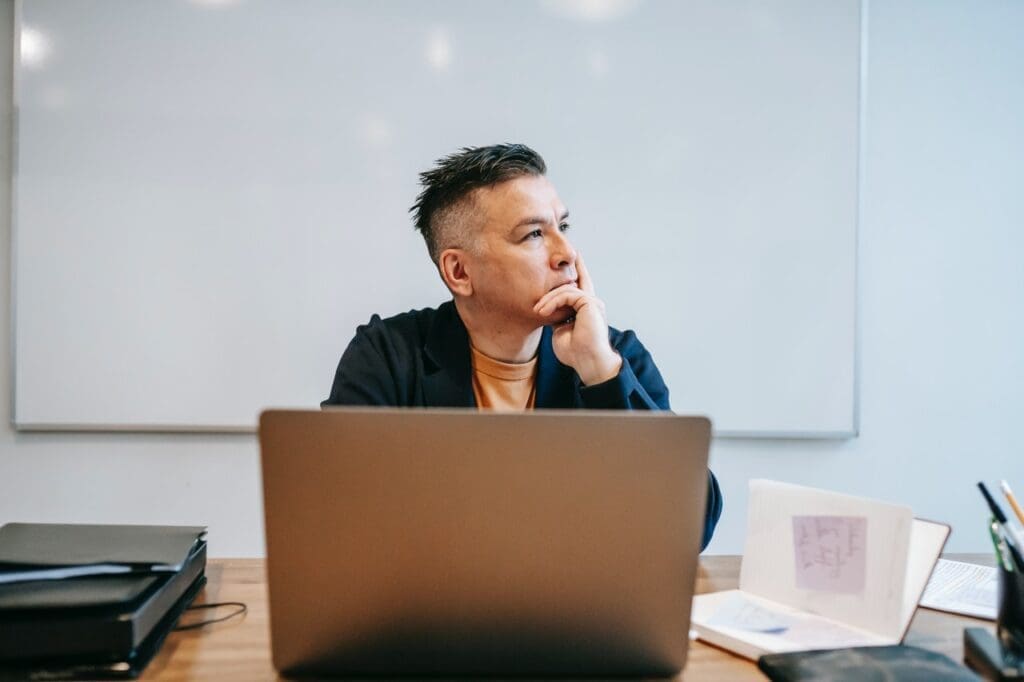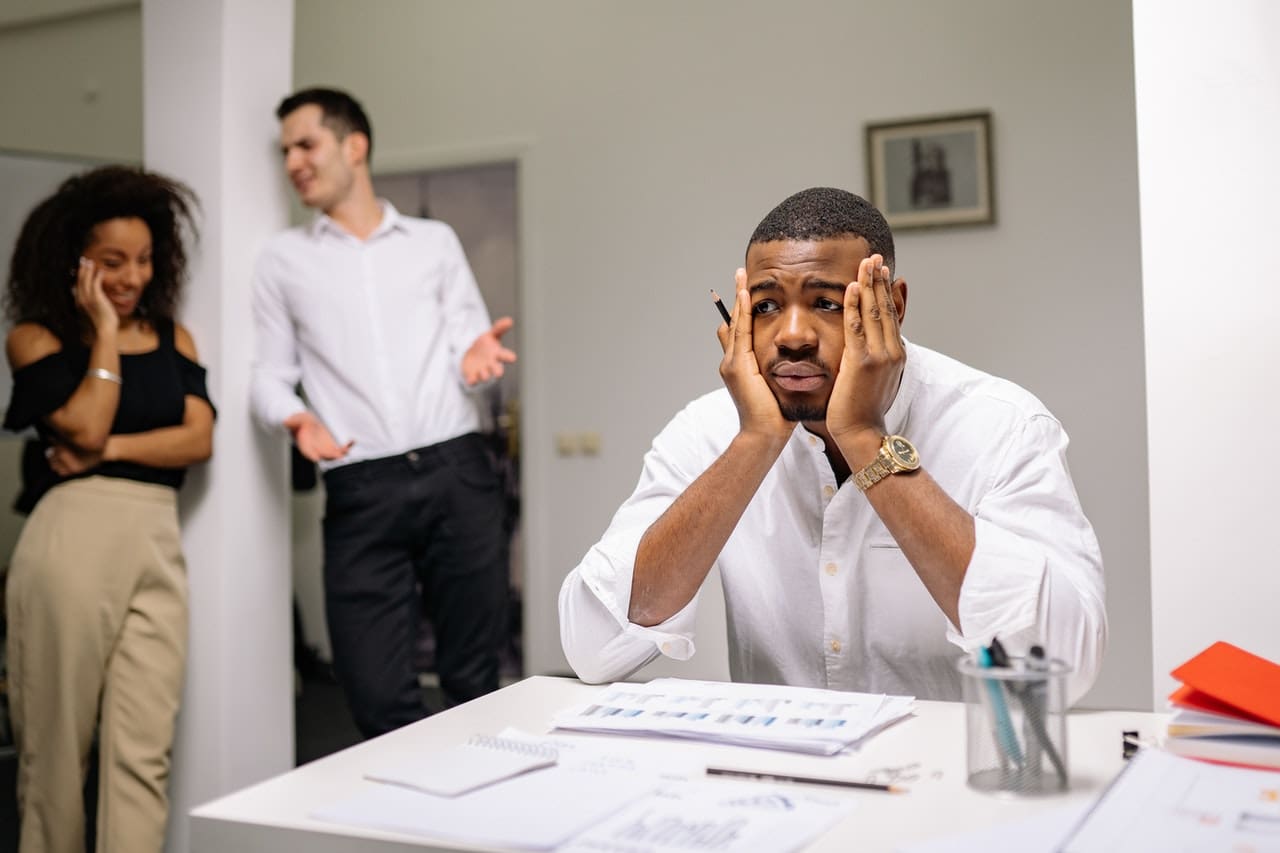Stuff happens. Often, our work settings provide the potential for a lot of stuff to happen. Deadlines, office politics, overlapping/competing job priorities, strong personalities can all be ingredients for a good old-fashioned “sh*t sandwich.” So, how do we best deal with setbacks and difficult people at work?

KEY POINTS
- Five steps you can take today to help you deal with difficult people and situations that arise in the workplace.
Dealing with difficult people at work
We all know that working with difficult people is often unavoidable. Most of us don’t get to choose our coworkers. Difficult people and situations can be a little easier to manage in our personal lives since we have a lot more latitude. At work, we can quickly find that the struggle to balance professionalism and good quality work with dealing with distractions and setbacks is very real.
The good news? Mindfully approaching our setbacks and dealing with difficult coworkers makes it much less problematic and helps us move forward. We keep our sanity, maintain our productivity, and help us complete our work and projects on time.
My Recent Experience
Recently there were a couple of examples of this happening for me; dealing with setbacks and difficult people at work.
The Analyst Presentation
My manager asked me to be part of a big presentation to outside analysts. It was an honor to be involved and would be a big feather in my cap. There were two presentations, another person would take one, and I would take the other.
We started working through the specific requirements and the features we needed to present as part of that presentation. Early on, the other person became what I felt to be somewhat critical of what I was doing and my work. He blatantly suggested that he take over both presentations.
Now, I experienced a variety of emotions about this. It didn’t sit well with me. I felt disrespected and undermined. I thought that this was maybe a little bit vindictive. It seriously bothered me for a few days.
The Customer Projet
A second situation that happened for me recently was when I was getting onto a new project. I was also working with other team members, and there was one team member who had been on the project for quite a while. He had a lot of knowledge about what was going on and had many opinions about how things should work.
My contribution to the project was to bring a certain amount of knowledge and expertise in this particular area of which was not his area of focus. So I collaborated with him and the rest of the team to build value in this customer project.
This person had solid opinions about how I should do things, what he wanted me to do, and what he wanted me not to do. He had no problems voicing his opinions strongly. In an emotionally charged conversation, he was being very combative, angry, and challenging. He was telling me how to do my job.
Ways to Get Past Uncomfortable Situations and Difficult Coworkers
So with that in mind, here are five ways to deal with setbacks and difficult people at work.
Pause and Reflect

The first is to pause and reflect, just take a step back. Take a breath. Don’t let your immediate reaction take control. Try to be that distant observer.
In my second situation of dealing with the person on the project, I took a pause. I sat back and reflected on what was happening and knew how I would react, and became mindful of how I could respond. I was able to make the proper choice of how I should respond and keep the conversation and keep the situation focused on what it was really about.
I didn’t let it be about personal feelings, not let it be about emotions, not about power trips or anything like that. How do we work together to get the work done? That was what I kept it focused on in my other situation where I had the presentation.
I eventually realized that I needed to pause, reflect on what was happening to me, and make the proper choices. So I did let my emotions get control of me in the beginning. I let my immediate reaction take control. I was able to pull that back and pause and reflected on making the proper choices and salvage the situation.
Sit With and Observe your Emotions
The next thing is to sit with and observe your emotions. So you have feelings about certain things, you have emotional reactions to something, and that’s okay. Our feelings are information. They tell us about what’s going on. The difference is, we need to take it for what it is and say, okay, I got the message, I understand what’s happening, and then move on.
We don’t want to let that let those emotions drive what our actions are.
For example, in my first situation with the presentation, my first reaction was anger. I was very disturbed. I was feeling threatened. I was feeling disrespected and was just really, really angry about the entire situation. I let my emotions take control.
Fortunately, I didn’t react at the moment in the way that I had wanted to. I had enough awareness to say I don’t need a lash out at this person, even though that’s what my mind, what my ego was telling me.
I was able to sit with and observe the emotions I had, and I just let them serve their purpose. Let them give me the information. That’s what happened in my second situation, where I was being personally attacked.
I was being dictated to by someone on how to do my job. And this was a person that really didn’t have the authority to tell me how to do my job. I just let that be. I just let that sit, and I was observant of how I reacted to that. What emotions it stirred up and what was going on inside my body.
Being aware of that and understanding how I should react and not let those emotions make those choices for me.
You also want to validate and challenge your feelings. In that situation, my first instinct was to become angry, and of course, that was a valid response.
But then I challenged that to say, “Is that really what’s going on here? No, this really isn’t about me, even though he’s telling me how to do my job. He’s dictating what will happen and really trying to assume an authoritative role over me.”
I realized that that’s not what’s really the issue. I challenged those emotions and was able to keep them in check, stay the course, and find the right solution. I was able to do this by sitting with and observing my emotions.
Why Did This Happen for Me?
The next thing you want to do is ask yourself: “Why did this happen for me?”
I began to understand that this is not something that happened to me; it happened for me. Meaning that I need to look at this as an opportunity. This has happened. What now am I supposed to learn from this? How do I turn this situation into a positive for me?
In my first situation with the presentation, I think it happened for me because I was supposed to learn how to deal with that and realize that my initial reaction, my initial lens, was not the proper way to respond to it. It was not the proper way to deal with a coworker and to deal with that situation. And so, I was able to learn from the situation.
My takeaways were that I should pause and reflect, sit with my emotions before reacting, and really understand what I was supposed to take away from the situation.
Why did this happen for me? It challenged me. It validated that my approach to this was a better approach and a way that I could move forward and deal with the situation with someone with whom I had to continue working. I was able to salvage that relationship and continue to have the project move ahead. Without losing my respect, I did it without losing my position or value to the other people’s overall project.
Asking “Why did this happen for me?” is an important question to really understand when we’re dealing with setbacks and difficult people.
Get the free guide Quiet Confidence: A Men’s Guide to Living a Free, Authentic, Joyful, Centered, & Purposeful Life”
This workbook will provide you with an introduction to mindfulness as a foundation for living a more deliberate, authentic, purposeful life of peace, freedom, health, and fulfillment.
You’ll also signup for the newsletter to get valuable content right in your inbox.
Your privacy is respected. Data will never be sold or shared. Unsubscribe at any time.
What Happens Now?
Next is determining what happens next. What do you need to do immediately? What do you need to do long-term? Explore all of those options.
In my first situation with the presentation, I immediately needed to pause and just take a step back to not react and reflect on that situation. I was fortunate in that this happened on a Friday, which, you know, is not the greatest of times for this to happen. Still, it put in a built-in pause over the weekend that allowed me to reflect on what happened, what I needed to do next, how to move forward, and what else I needed to do.
In that case, it was to have a conversation with that person and say, “Here’s the conclusion that I’ve come to. I think that this would be the best way forward for you to do this. And here’s why, and this is what I think.”
It was not my cow-towing to him again. I wasn’t saying “I think you’re better than me.” It wasn’t my acceptance that this reflected on me or a reflection of how I do things. Instead, it was what I thought to be the best thing going forward.
When we spoke to the rest of the people involved in the presentation, we said we concluded that this would be the best way forward. That was me being a team player, making the best decision, and understanding my next steps.
In my situation with the project, I knew that my next steps were to pause to get feedback from other people. And to not speak nor give my opinion, but to listen to what the other person said, and then decide the next best course of action.
Knowing that long-term, I would have to work with this person, my next steps were to have that conversation. I needed to do that in a way that did not diminish my position or make me seem like a pushover. I held my ground and being empathetic and compassionate towards the situation, knowing that this person may have their own stuff going on.
I explore all my options and making sure I have the best option going forward.
Let Go
Finally, just let it go. Let it go and move on. Sit with your emotions, observe how they react, how you respond to them, take whatever learnings you have from that situation, and move on.
Don’t let it linger. Don’t let it stay with you. Just deal with it and be done with it.
There is an old story of two monks that are walking and come to a river. The river doesn’t have a bridge or crossing and is moving swiftly and deep.
There, they see a woman standing on the bank, looking frustrated. She has a small frame, and so it’s challenging for her to cross the river. So one of the monks offers to carry her across. He picks her up, and all three cross the river. On the other side, the woman is set down, and the monks continue their journey.
Later that evening, the other monk says to the first monk, “Why did you help that woman? Why did you pick up that woman? We have been taught that it is dangerous for us as monks to contact women like that. Why did you do that?”
To which the other monk replies, “Are you still carrying that woman around? I left her back at the river.”
Just move on and let it go.
Putting It All Together
To sum up, these are five ways to deal with setbacks and difficult people at work:
- Pause and reflect, take a step back, don’t let your immediate reaction take control, and try to be the distanced observer to sit with and observe your emotions.
- Have your feelings about it, and then know that those are. Okay, let them be, and then let them serve their purpose, validate and challenge your emotions.
- Think about why did this happen for me? Ask yourself, why did it happen? What are you supposed to learn? How is this a learning experience for you?
- What happens? Now, what do you do next? What do you do now, immediately? Long-term, and then,
- Just let it go.
And hopefully, with that, you will be able to deal with these situations much better as I am learning to
“Good questions outrank easy answers.” – Paul A. Samuelson (American economist)
- What were some of the most difficult moments at work for you in recent years?
- Have you ever had to confront someone you work with about something that was uncomfortable?
- What are your go-to coping techniques and strategies for handling difficult conversations – whether it’s with your boss, a coworker or even yourself for self-motivation?
Want more? Get the free guide “Quiet Confidence: A Men’s Guide to Living a Free, Authentic, Joyful, Centered, & Purposeful Life“
This workbook will introduce mindfulness as a foundation for living a more deliberate, authentic, purposeful life of peace, freedom, health, and fulfillment.






